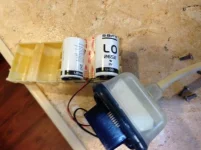Well, you know after all this discussion, I couldn't resist taking this thing apart just to see what they used, if nothing else. Simple, just 4 screws....In fact I had not noticed before, cast in the plastic at the bottom, it even tells you to remove those 4 screws and disconnect the battery in the event of unwanted transmission.
What the battery is, is simply 3 Lithium 3 volt D cells.....connected together by their standard solder tabs, with two or three resistors, plus one fuse. A no brainier for those with basic solder experience to recreate with 3 new batteries.
The batteries are very good batteries...SAFT model LO26SX. Average cost is $17.95 each....so, about $54 plus shipping to get this particular EPIRB back to full charge.
FWIW, my battery pack measures 8.9 volts.....which is not that good really, since the new voltage is a nominal figure. In reality a new Saft 3v lithium probably measures about 3.4 volts, so the pack reading new should be over 10 volts.
I see now the method the case is sealed, and with a new O ring there would be absolutely no danger of the unit allowing water intrusion via DIY battery change. In fact I was surprised to find the 4 screws on mine were not tight at all, to the extent I wonder if this unit would have survived submersion without leakage if I had not messed with it to find that out.
As it is possible that ACR rigged the software to go into an error mode if power is disconnected, requiring a secret method to reboot it, I don't know if I will change the batteries or not. might be worth $60 just to satisfy my curiosity in that matter.
Having said all this I do NOT recommend that others try to DIY change their EPIRB batteries....just presenting the facts that might interest a few of you. In fact other models of EPIRBs might be more difficult to deal with than this ACR Satellite 2, 406 model and might even have custom batteries.
I will buy a new unit if we plan on boating offshore on a regular basis, but I figure this one will be better with new DIY batteries than it would have been left as is, so better than nothing in the near zero chance it is needed inshore for now.


